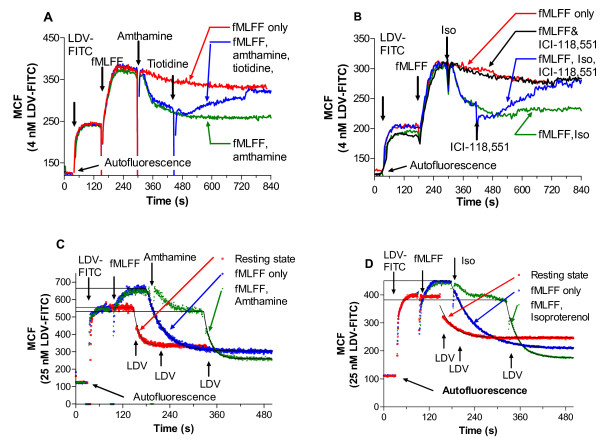Figure 2.
Binding and dissociation of the LDV-FITC probe in response to Gαs-coupled receptor agonists and antagonists. A, B, The effect of Gαs-coupled receptor antagonists. U937 cells stably transfected with the non-desensitizing mutant of FPR were sequentially treated with the LDV-FITC probe (4 nM, below saturation), fMLFF (100 nM), and A, amthamine (500 nM), tiotodine (10 μM), or B, isoproterenol (1 nM), ICI-118,551 (10 μM). B, Additional control sample was treated with the same concentration of LDV-FITC, fMLFF, and ICI-118,551 without addition of isoproterenol to show the effect of Gαs-coupled receptor antagonist without addition of the agonist. The MCF value corresponding to cell autofluorescence is indicated by the horizontal arrow. Data are plotted as MCF versus time. One representative experiment out of three experiments is shown. C,D, Kinetic analysis of binding and dissociation of LDV-FITC probe on U937 cells stably transfected with the non-desensitizing mutant of FPR. Cells were sequentially treated with the LDV-FITC probe (25 nM, near saturation), Gαi-coupled receptor ligand (fMLFF, 100 nM), Gαs-coupled receptor ligands, C, amthamine (500 nM), or D, isoproterenol (100 nM). At time points indicated by arrows, cells were treated with excess unlabeled LDV containing small molecule (2 μM), and the dissociation of the fluorescent molecule was followed. Dissociation rate constants (koff) were obtained by fitting dissociation curves to a single exponential decay equation (as described in the text). Experiments shown in the different panels were performed using different instruments, and therefore MCF values are not identical.

